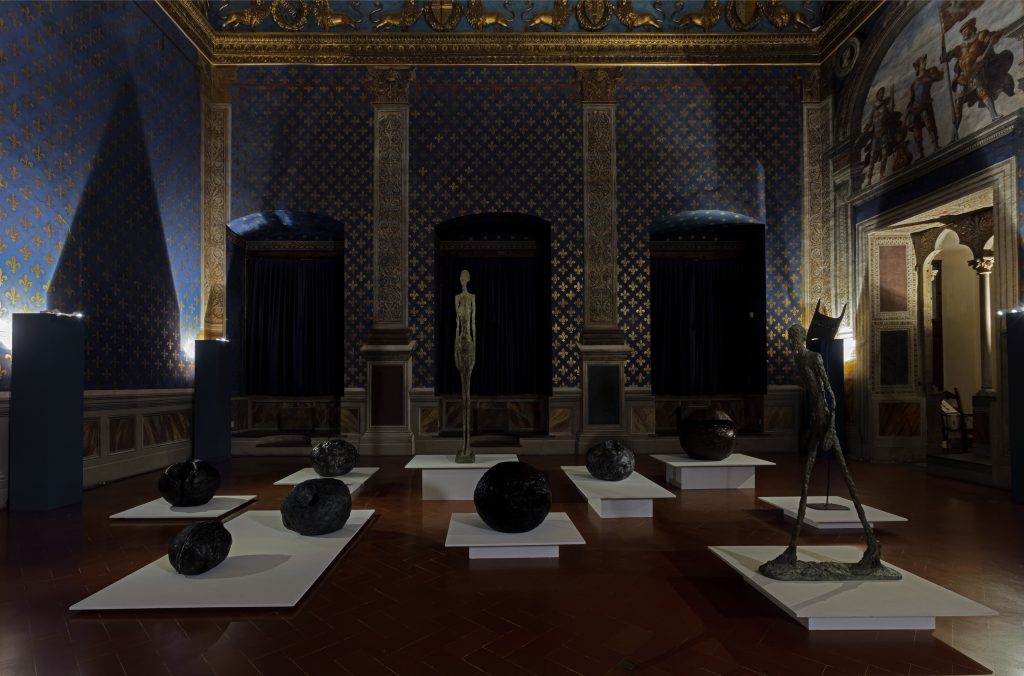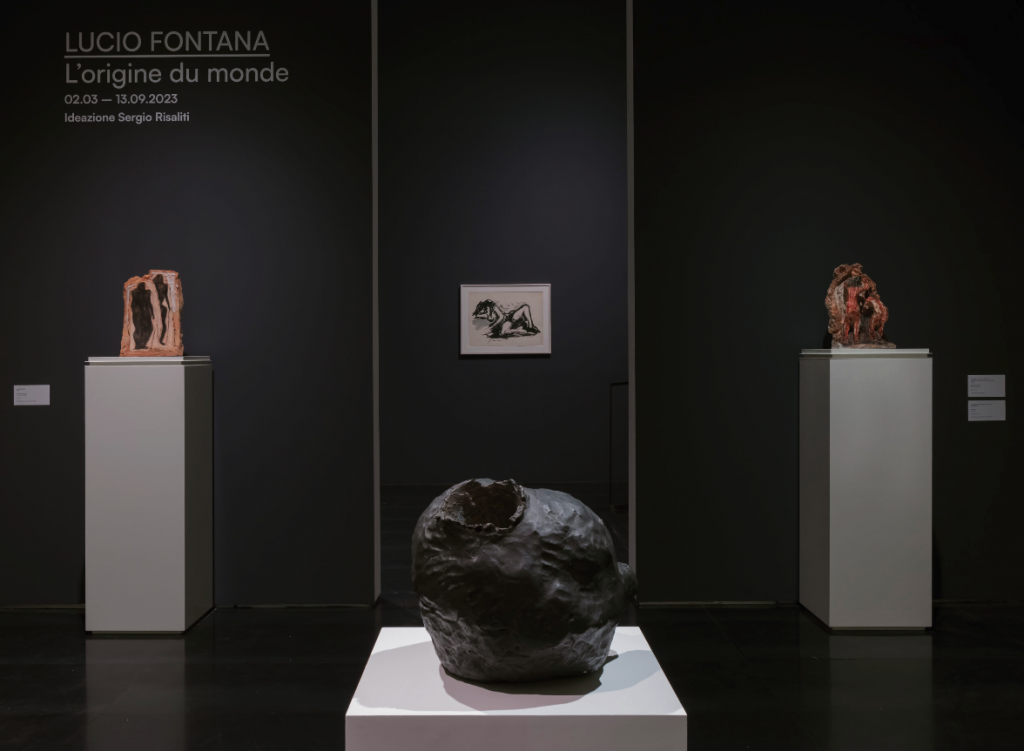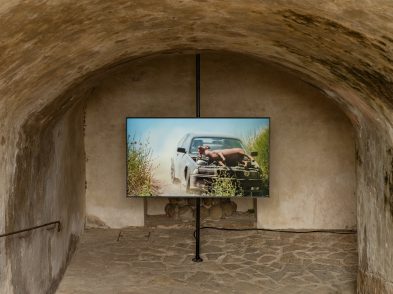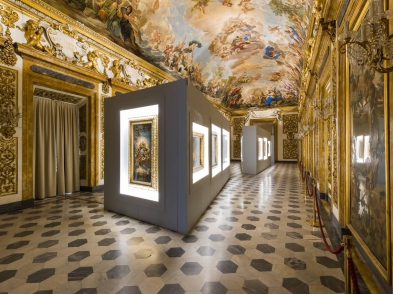A remarkable encounter is taking place in the Sala delle Udienze and Sala dei Gigli at Palazzo Vecchio between two of the most important artists in Europe in the last century. Although most associated with painting in the decades immediately after the Second World War, both men made sculpture by moulding clay and plaster that had its own dynamic power. Yet the careers of Swiss artist Alberto Giacometti (1901-66) and Italian Lucio Fontana (1899-1968) began in the years before the conflict and, for both men, the war coincided with major changes in their artistic outlook that established their reputations.

The work of Giacometti and Fontana was reborn during WW2. Prior to that time, their work was set on different foundations. Giacometti was grounded in surrealism. Working in Paris in the 1930s, he gravitated by instinct towards the writers, philosophers and artists fascinated by the “superior reality” of the subconscious mind. Their fascination with eroticism, mysticism and the irrational manifested, for example, in the uncanny imagery of dreams. He met the essayist and anthropologist Georges Bataille, whose ideas were inspirational. One concept was his transgressive philosophy of base materialism that dissolved aesthetic categories, such as high and low culture into a kind of formlessness that defies strict definition.
Formless is not a disorganised mess. In art terms, it cancels boundaries of type and meaning that proliferate in the arts. Giacometti’s sculpture, Invisible Object (Hands holding the void) (1934) included here, attempts to do that. The stylized upright female figure balances on a cage-like throne, but a board against her shins restrains her movement. Giacometti’s first large-scale and anatomically complete human figure, the artist modelled the head on a protective metal mask he found. Its unsettling effect is underscored by the position of her hands. They appear to offer or hold something but are in fact empty, as the work’s title implies. That absence is a haunting detail, like a Madonna missing the Christ child.
After the war, which he spent in Switzerland, Giacometti’s theme shifted resolutely to the realism of the human subject and, specifically, to the situation of man. Now working exclusively from the model, his work linked the figure to expressiveness at just the time when American painters like Jackson Pollock and Mark Rothko were reflecting the contemporary post-war spirit in totally abstract terms. Giacometti’s impassive female and male bodies always seem far away. However close the viewer stands, there is no more to see than at a distance. His figures show themselves totally and at once, as if just coming into view and seemingly shaped by the surrounding atmosphere, especially the light, which somehow erodes them. The philosopher Jean-Paul Sartre wrote that Giacometti “has restored an imaginary and indivisible space to statues. He was the first to take it into his head to sculpt man as he appears, that is to say, from a distance.”
The figures are always vertical, since Sartre (now the major influence) equated perception with walking, with travelling across a space, with doing things. Dreaming is lying down; awareness is upright. And this perception exists beyond the self: these sculptures imply that man is at one with the world that motivates him. Ranged around them in the palazzo are several curious, dark, gnarled-looking spheres: the essence of formlessness. The poor installation of this show, which puts work on white plinths like flea-market tables in darkened spaces to preserve the historic decoration, is a hindrance to identifying the wonderful surfaces of these sculptures. Each cratered shape resembles a giant seeds or meteorite—their origins are unclear—cleaved by a gash penetrating to the core from an unknown violent impact.
For Lucio Fontana, these spherical Concetto spaziale, Natura sculptures evoke the mysterious and infinite dimensions of space. Their creviced, lunar-like topography also crosses boundaries in interpretation: simultaneously dense and weighty, hollow and potentially changeable, one writer described them as “a space beyond space, an interior space, dark and mysterious.” Science and art were indivisible for this artist; the infinity of space fascinated him: he was already using illumination like neon and Wood’s lamps emitting black light by the early 1950s, spurred on by his interest in technology and experiment. Indeed, he sought to challenge sculpture’s preoccupation with volume (at art school in Milan he had learned to work in marble) by preferring materials, such as plaster, ceramic, terracotta, which he moved with his hands into turbulent surfaces that reflect light back into the viewer’s space so that a kind of communication takes place between them.
Originally made in clay between 1959 and 1960, 33 spheres were cast in bronze with the biggest measuring over 65 centimetres in diameter. Why bronze? Although Fontana produced some of the most dynamic ceramic sculptures of the last century, the heavy metal enabled him to set up an extraordinary contrast. The violent manipulation of material by wound-like splices and holes disturb, disrupt and fragment any sense of “wholeness”; the interior is exposed, violated even, so that views of inside and outside interconnect. Like Giacometti’s figures, however, Fontana relates these objects to the body and its orifices, so they are both cosmological and physically erotic.

Not surprisingly, the artist wrote to the American collector Peggy Guggenheim in 1959 that, “This summer, at Albisola… I have almost produced thirty very large terracotta spheres, with holes and large cuts. I am very pleased. I have managed to represent nothingness! This is the death of matter, pure life philosophy! Fontana’s multifaceted Nature convey anxiety in a tangible manner about threatening and formless external factors, about the nothingness of space just when man was on the brink of exploring an infinitely large universe. Uncovered by scientific discovery, the scope of space lay beyond conventional forms of religious belief. In 1964, Fontana gave the title Concetto spaziale, La fine di Dio (Spatial Concepts, The End of God) to an egg-shaped painting, perforated by numerous puncture marks that let light and space penetrate the canvas in reality rather than as an illusion.
Fontana was born in Argentina, the son of an emigrant Italian commercial sculptor who made funerary monuments. From age 20 he went back and forth between old and new worlds, returning to Italy in the 1930s. His artistic personality was not yet fixed, shuttling between avantgarde abstract geometric shapes in sculpture and a pre-modernist figurative style favoured by the Novecento group close to Mussolini’s regime. His Signorina Seduta (1934) typifies that phase when Fontana was, effectively, making “official” art, and making a living. Shown here alongside Giacometti’s Invisible Object, its inspiration comes from different sources to Giacometti’s, as diverse as antiquity and Edgar Degas. Cast in bronze, the figure was also painted, still then an unusual feature in sculpture: academic theorists since the 18th century had deplored polychromatic sculpture. Yet colour highlighted the work’s materiality, which was already Fontana’s objective.
Back in Argentina during the war, Fontana’s artistic voice leapt forward when, in 1946, his ‘Manifesto Bianco’, co-written with his students, appeared. Now a seminal text of modernism, it encouraged artists to overcome the limitations of canvas and project lights in space. “We refuse to think of science and art as two distinct phenomena…Artists anticipate scientific deeds; scientific deeds always provoke artistic deeds.” The new concept called spazialismo emerged that Fontana pursued on his return to Italy the following year. An art of instinct, liberated from ideas, it accounts for his enduring importance.
As both painter and sculptor, he strove to introduce the third dimension into his canvases and objects by means of perforations and slashes: the buchi and tagli for which he is famous. This profound action confirmed the artist’s belief, expressed in 1967, that “making a hole was a radical gesture that broke the space of the picture as if to say: after this we are free to do what we want.” The complementary exhibition at Museo Novecento charts beautifully the evolution of ideas that have left a permanent mark on what constitutes an artwork. As well as his rhythmic cuts and random holes piercing thick layers of pigment, he used reflective materials like glitter or glass fragments. Glass came in lumps from Murano, which Fontana shattered in his studio. He created entire environments of coloured light and corridors that viewers walked around to experience transformed spaces. Notions of high and low art became blurred, at the risk of becoming kitsch. Fontana was not bothered. In New York for the first time in the late 1950s, he pierced sheets of copper, brass and aluminium so that light bounced off surfaces to take in surrounding space, just like the city’s metal and glass skyscrapers.
With Fontana, as with Giacometti, at their most electric, the viewer is embroiled in the work, an active part of their art.






